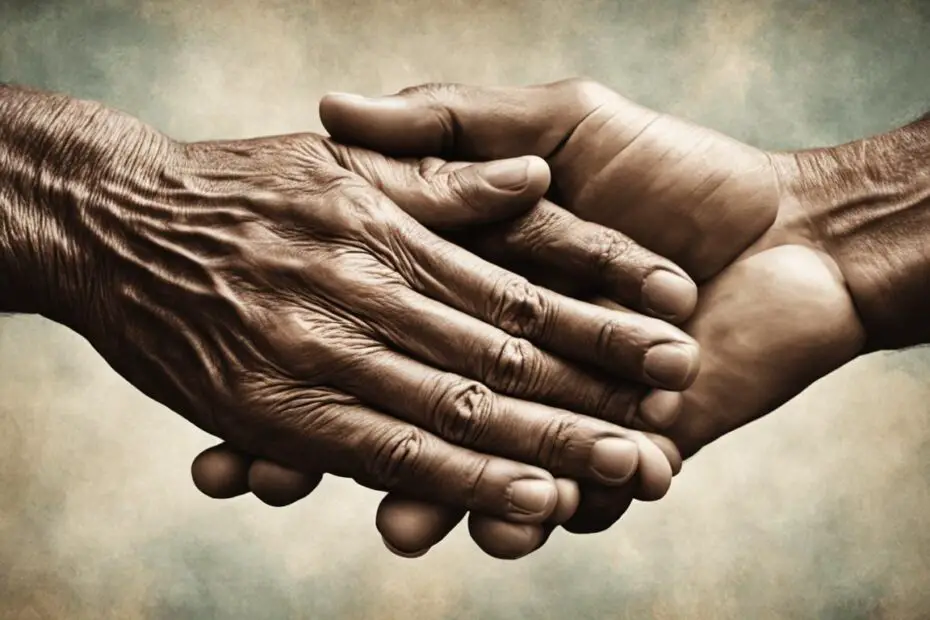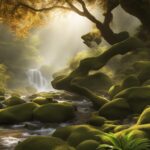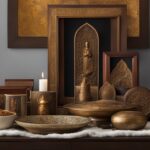Prayer is a universal language that transcends religious boundaries. It is a powerful act of communication with a higher power, where individuals seek solace, guidance, and connection. One common gesture associated with prayer is the clasping of hands, commonly known as traditional prayer hands. This religious hand gesture holds deep symbolism and is significant in various spiritual traditions.
Classical representations of traditional prayer hands can be found in artworks, religious texts, and even tattoos. The gesture of clasping hands in prayer is a visual representation of spirituality and devotion. It is a gesture that invokes feelings of reverence, humility, and surrender to a higher power.
Key Takeaways:
- Traditional prayer hands are a symbol of spirituality and connection with a higher power.
- The clasping of hands in prayer represents reverence, humility, and devotion.
- This religious hand gesture is significant in various spiritual traditions.
- Praying hands have been depicted in artworks and have become popular tattoo designs.
- The symbolism behind traditional prayer hands resonates deeply with individuals seeking faith and spiritual connection.
The History and Significance of Praying Hands
Praying hands have a long and rich history, holding deep significance in various religions. This traditional hand gesture carries profound symbolism and invokes spirituality and devotion.
In Christianity, clasping the hands together in prayer is a powerful representation of humility, surrender, and a personal connection with a higher power. It signifies a reverence for God and an acknowledgment of His presence in one’s life.
Similarly, in Islam and Hinduism, the gesture of praying hands reflects deep devotion, supplication, and respect for the divine. It is a means of humbly seeking blessings, guidance, and spiritual fulfillment.
This traditional spiritual icon has transcended its religious boundaries and has become a universal symbol of faith and spirituality. Praying hands have been immortalized in famous artwork and have captured the hearts of believers worldwide.
“Praying hands are the embodiment of our longing for a connection with something greater than ourselves.”
Praying hands tattoos have also gained significant popularity, serving as a personal expression of one’s faith and spiritual journey. Individuals choose to permanently ink these symbols to carry a constant reminder of their devotion and the values they hold dear.
The symbolism behind praying hands is profound, evoking a sense of peace, hope, and guidance. It is a visual representation of the eternal bond between humanity and the spiritual realm.
To visually illustrate the significance of praying hands, please refer to the image below:
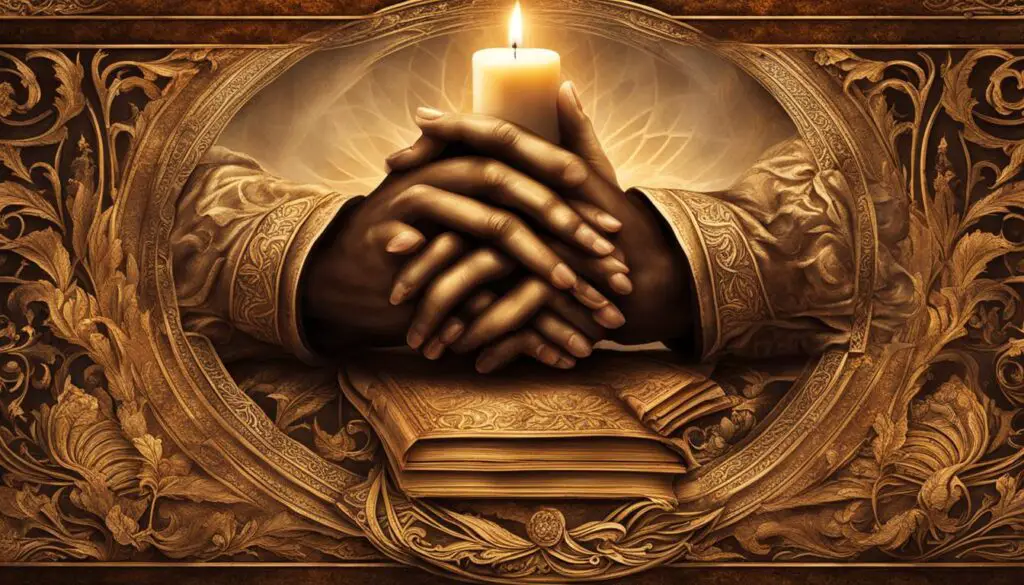
The Significance of Praying Hands in Different Religions
While the praying hands gesture holds universal spiritual and religious significance, its interpretation may vary across different faith traditions. Here is a summary of the meanings associated with praying hands in various religions:
| Religion | Meaning of Praying Hands |
|---|---|
| Christianity | Humility, Surrender, Connection with God |
| Islam | Devotion, Supplication, and Seeking Blessings |
| Hinduism | Reverence, Spiritual Fulfillment, Seeking Divine Guidance |
The gesture of praying hands transcends cultural and religious boundaries, uniting believers in their shared quest for spiritual connection and understanding.
Praying Hands in Tattoo Art
The praying hands tattoo is a powerful symbol of faith, devotion, and spirituality. It holds deep meaning for individuals who choose to immortalize this religious hand gesture on their skin. Praying hands tattoos can be designed in various styles, allowing for personal expression and creativity.
From realistic depictions to more abstract designs, each tattoo design carries its own unique significance. Some individuals opt for intricate details, while others prefer minimalism to capture the essence of the traditional prayer hands. The choice of style often reflects the wearer’s personal connection to spirituality and their desire to visually represent their beliefs.
Placement of the tattoo also holds significance. While some people choose to have praying hands tattoos on their arms or shoulders, others opt to have them on their palms. Placing the tattoo on the palm symbolizes a deeper connection to prayer, with the hands being a conduit for spiritual communication.
“The praying hands tattoo serves as a constant reminder of one’s faith, values, and commitment to a higher power. It is a testament to the individual’s devotion and serves as a visual representation of their spiritual journey.” – Tattoo enthusiast
The emotional and spiritual connection individuals have with their praying hands tattoos goes beyond mere body art. These tattoos serve as personal and meaningful reminders of their faith, providing comfort and strength during times of prayer and meditation.
Praying Hands Tattoo Design Ideas
| Design Style | Description |
|---|---|
| Realistic | A highly detailed representation of praying hands, capturing the texture, shading, and depth of the hands. |
| Minimalist | A simple and clean design with clean lines and minimalistic details, focusing on the essential elements of the prayer hands. |
| Watercolor | A vibrant and colorful interpretation of the praying hands, using watercolor-like techniques to create a unique and striking design. |
| Geometric | An abstract approach to the praying hands, incorporating geometric shapes and patterns to create a modern and visually intriguing design. |
| Negative Space | A creative use of negative space, allowing the outline of the hands to form a significant shape or symbol within the tattoo. |
The variety of design options allows individuals to choose a style that resonates with their personal taste and spiritual beliefs. Whether it’s a lifelike representation or a more abstract interpretation, the praying hands tattoo serves as a visual testament to one’s faith and the power of prayer.

The Gesture of Hands Clasped in Prayer
Clasping hands in prayer is a universal practice found in many religions, symbolizing surrender, solace, and connection with a higher power. The act of bringing hands together in this gesture represents humility, devotion, and reverence.
Throughout history, people of different faiths have used clasped hands in prayer to express their spirituality and seek divine guidance. It is a physical manifestation of our innermost thoughts, feelings, and intentions.
“In every religion, there is an element of surrender, of giving up one’s own will and ego to a higher power. Clasping hands in prayer is a physical representation of this act of surrender and devotion.”
The clasped hands in prayer hold deep symbolism and serve as a visual reminder of our connection with the divine. It is a powerful and timeless gesture that transcends cultural and religious boundaries.
A Gesture of Humility and Reverence
The gesture of clasping hands in prayer embodies humility before a higher power. By bringing our hands together, we acknowledge that we are finite beings in the presence of the infinite. It is an expression of our recognition of the divine’s greatness and our own finite nature.
Moreover, clasping hands in prayer signifies reverence. When we join our hands together, we show respect and honor towards the divine. It is a gesture of acknowledging the sacredness of the moment and the presence of the divine.
A Symbol of Unity and Connection
Clasping hands in prayer is also a symbol of unity and connection. When we bring our hands together, we unite our mind, body, and spirit in a harmonious way. It serves as a reminder of the interconnectedness of all beings and our shared humanity.
Furthermore, clasped hands in prayer symbolize our connection with the divine. It is a way of reaching out, seeking guidance, and establishing a spiritual rapport with the higher power we believe in.
The Spiritual Power of Clasping Hands in Prayer
The gesture of clasping hands in prayer holds immense spiritual power. It allows us to enter a state of deep reflection, mindfulness, and peace. As we bring our hands together, we create a sacred space within ourselves to commune with the divine.
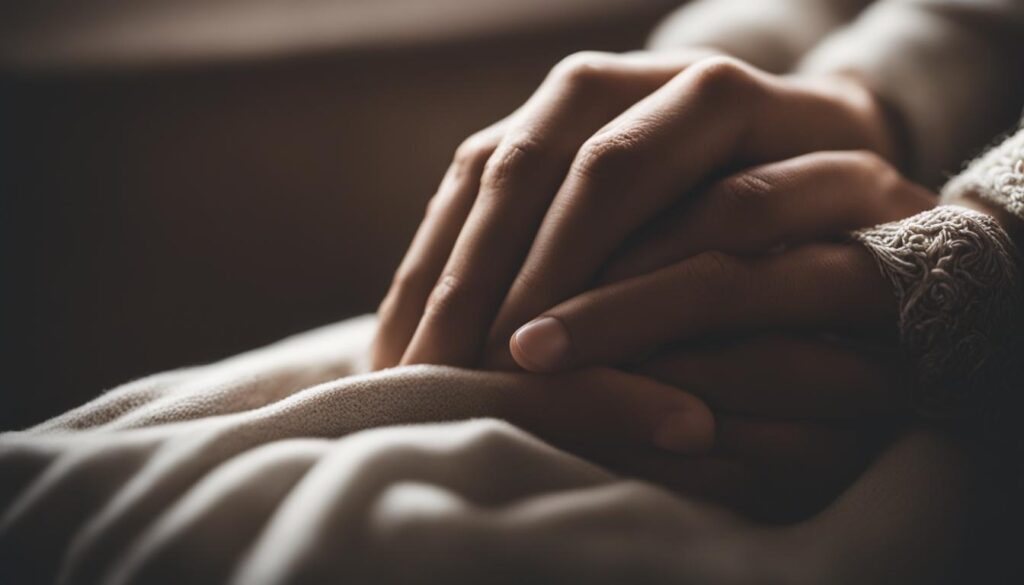
A Visual Representation of Faith
Praying with clasped hands is not only a personal act of devotion but also a visible sign of one’s faith. The symbolism of this gesture is so profound that it is often depicted in religious art, sculptures, and tattoos.
| Religion | Depiction |
|---|---|
| Christianity | Depictions of clasped hands in prayer are commonly seen in Christian art, symbolizing humility, surrender, and submission to God’s will. |
| Islam | Clasped hands in prayer, known as the “du’a” pose, are often depicted in Islamic art as a symbol of devotion and supplication to Allah. |
| Buddhism | In Buddhist art, clasped hands represent a respectful gesture towards the Buddha and signify a devotee’s commitment to the path of enlightenment. |
The visual representation of clasped hands in prayer serves as a reminder and inspiration for believers to cultivate a deeper connection with their faith and spiritual journey.
The gesture of clasping hands in prayer is a timeless practice that unites people of different cultures, religions, and backgrounds. It transcends language barriers and speaks to the universal longing for spiritual connection and guidance. Whether in prayer or in artistic depictions, clasped hands symbolize the profound spirituality that resides within every individual.
The Symbolism of the Orans Posture
The orans posture is a powerful religious hand gesture that holds deep symbolism in Christianity. It is the oldest known gesture of prayer, dating back to early Christian times. In this posture, the arms are extended and raised, with the palms facing upward.
The orans posture is a physical manifestation of surrender and openness to God. By raising the hands, individuals symbolically open themselves up to receive God’s grace and guidance. It is a gesture of trust, acknowledging that God’s will is greater than one’s own.
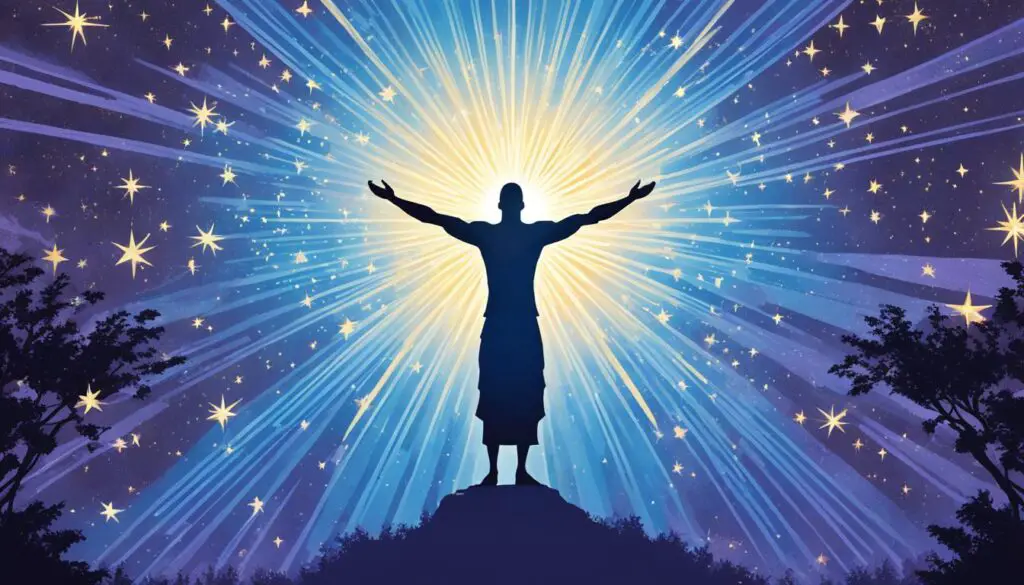
The extended arms in the orans posture also hold symbolic significance. They represent the crucifixion of Christ, reminding believers of His sacrifice for humanity’s salvation. Furthermore, the outstretched hands symbolize an invitation for others to come and join in prayer and worship.
Key Symbolism of the Orans Posture:
- Surrender: The orans posture signifies a willingness to surrender to God’s will and guidance.
- Openness: By extending the arms, individuals open themselves up to receive God’s grace.
- Crucifixion: The outstretched arms symbolize the crucifixion of Christ, emphasizing His sacrifice for humanity.
- Invitation: The extended hands symbolically invite others to join in prayer and worship.
The orans posture deeply resonates with individuals seeking a spiritual connection with a higher power. It serves as a physical representation of faith, trust, and surrender in prayer. Whether used in personal devotions or in communal worship, the orans posture stands as a powerful symbol of spirituality and reverence.
The Significance of the Sign of the Cross
When it comes to Christian prayer gestures, few are as iconic and powerful as the sign of the cross. This traditional hand gesture carries deep symbolism and meaning, representing faith, hope, and protection. Through this simple but profound act, individuals confess Christ’s crucifixion and call upon the Triune God.
The sign of the cross is commonly performed by touching the forehead, chest, left shoulder, and right shoulder, tracing the shape of a cross with the hand. This gesture is often accompanied by a spoken or silent prayer, reinforcing its connection to spirituality and devotion.
In the context of religious ceremonies, the sign of the cross holds special significance. During Eucharistic prayers, the priest blesses the offerings and the congregation with the sign of the cross, invoking spiritual blessings and divine protection.
| Symbolism | Explanation |
|---|---|
| Faith | The sign of the cross represents unwavering faith in the Christian belief system, acknowledging and affirming the central tenets of Christianity. |
| Hope | By making the sign of the cross, individuals express hope in the promises of God and trust in His divine plan. |
| Protection | The sign of the cross is a gesture of seeking divine protection and invoking the safeguarding power of God in every aspect of life. |
Just as praying hands symbolize humility and surrender, the sign of the cross embodies profound spirituality and reverence. It serves as a visible reminder of one’s faith, offering comfort and solace in times of distress and uncertainty.
“The sign of the cross is not only a prayer in itself; it also calls to mind the immense sacrifice made by Jesus Christ, who died on the cross for the salvation of all humanity. In making this gesture, we participate in the mystery of the cross and connect ourselves to the love and mercy of God.”
The Power of the Sign of the Cross
The sign of the cross is not merely a ritualistic gesture; it holds significant spiritual power. Through this act, believers seek to align themselves with the divine, inviting God’s presence into their lives and invoking His blessings.
For many individuals, making the sign of the cross is a deeply personal and sacred practice. It serves as a tangible connection to their faith, strengthening their relationship with God and igniting a sense of peace and spiritual renewal.

The Emotional and Spiritual Connection to Praying Hands Tattoos
Getting a praying hands tattoo can be a deeply emotional and spiritual experience for many individuals. It serves as a constant reminder of their faith, values, and spirituality. The design and placement of the tattoo can hold personal significance, and the tattoo itself becomes a physical manifestation of the wearer’s spiritual and emotional journey.
Praying hands tattoos are not just a mere fashion statement but a powerful symbol of devotion and connection to something greater than oneself. For those who choose to adorn their bodies with this sacred image, it is a way to carry their beliefs with them, creating a visible and permanent bond between their inner world and the external expression of their spirituality.
The choice of design and the way it is represented can vary, with some individuals opting for a realistic depiction of traditional prayer hands, while others may choose a more abstract or stylized interpretation that aligns with their personal aesthetic. The placement of the tattoo is also significant, with some people deciding to have it prominently displayed, such as on their forearm or chest, while others may prefer a more discreet location.
The emotional and spiritual connection to praying hands tattoos can be profound. These tattoos represent more than just a simple design; they encapsulate a person’s values, beliefs, and journey towards self-discovery. They serve as a visual reminder of the individual’s commitment to their faith and the principles they hold dear.
“I got my praying hands tattoo as a way to honor my religious upbringing and to always keep my faith close. It’s a symbol of the emotional connection I have with God and the comfort I find in prayer.” – Emily Johnson, tattoo enthusiast
For many, the act of getting a praying hands tattoo is a deeply personal and introspective process. It involves reflecting on one’s own beliefs, spirituality, and the role that prayer plays in their life. The tattoo serves as a visual representation of the individual’s commitment to their faith and their desire to maintain a spiritual connection in their daily lives.
In conclusion, praying hands tattoos go beyond mere body art. They carry a profound emotional and spiritual significance for those who choose to ink their bodies with this sacred symbol. Whether it is a representation of traditional prayer hands or a unique design, these tattoos serve as a powerful reminder of an individual’s devotion, values, and journey of self-discovery.
A Guide to Getting a Praying Hands Tattoo
Thinking of getting a praying hands tattoo? It’s important to approach this meaningful and spiritual symbol with care. Here’s a guide to help you through the process:
Choose a Reputable Tattoo Artist
When it comes to religious tattoos like the traditional prayer hands, it’s essential to find a tattoo artist who specializes in this style. Look for someone with experience in creating intricate designs and who understands the significance of religious symbols. Take your time to research and select an artist who can bring your vision to life.
Explore Different Tattoo Design Options
Praying hands tattoos can be customized to suit your personal style. From minimalist linework to vibrant watercolor designs, the possibilities are endless. Consider whether you prefer a realistic depiction or a more abstract interpretation. Think about the elements that resonate with you the most and discuss them with your chosen artist to create a design that truly reflects your beliefs and spirituality.
Consider Tattoo Placement
The placement of your praying hands tattoo can add another layer of significance to the design. Some individuals choose to have it prominently displayed on their chest, forearm, or back, symbolizing their unwavering faith and devotion. Others prefer a more intimate placement, such as the inner wrist, as a personal reminder of their spiritual journey. Reflect on which area holds the most meaning for you and discuss it with your tattoo artist.
| Tattoo Placement Ideas | Description |
|---|---|
| Chest | A powerful and visible placement to display your devotion. |
| Forearm | A popular choice for a tattoo that can be easily seen and admired. |
| Back | Provides a larger canvas for a more elaborate design. |
| Inner Wrist | An intimate placement that serves as a personal reminder. |
Remember, the placement of your praying hands tattoo is a personal choice. It should carry meaning and significance to you, ensuring that it is a constant source of spiritual connection and inspiration.
By following this guide and putting thought into your choice of tattoo artist, design, and placement, you can ensure that your praying hands tattoo is a powerful and meaningful symbol of your faith and spirituality.
Exploring Different Styles of Praying Hands Tattoos
When it comes to expressing one’s faith and spirituality through body art, praying hands tattoos have become a popular choice. These tattoos not only symbolize devotion and connection with a higher power but also serve as a visual reminder of one’s beliefs. While the concept of traditional prayer hands remains the same, the design and style of these tattoos can vary greatly, allowing individuals to choose a representation that aligns with their unique sense of style and resonates with their personal journey.
From minimalist linework to vibrant watercolor renditions, there are various tattoo styles to explore when it comes to praying hands tattoos. Each style carries its own artistic flair and conveys distinct emotions and meanings. Let’s take a closer look at some of the different design styles:
- Minimalist: Minimalist praying hands tattoos feature clean lines and simple outlines, focusing on the essential elements of the design. This style represents a stripped-down, understated approach and is beloved by those who appreciate a more subtle and refined aesthetic.
- Realistic: For those seeking a lifelike representation, realistic praying hands tattoos capture intricate details and shading, creating a three-dimensional effect. This style aims to bring the artwork to life through expert craftsmanship and attention to detail.
- Watercolor: Watercolor praying hands tattoos embrace vibrant colors and fluid brushstrokes, mimicking the delicate and unpredictable nature of watercolor paintings. This style exemplifies creativity and allows for a more abstract interpretation of the design.
- Neo-Traditional: Blending elements of traditional tattooing with modern techniques, neo-traditional praying hands tattoos offer a contemporary twist on a timeless symbol. This style incorporates bold lines, rich colors, and enhanced details, resulting in a visually striking and dynamic piece of art.
No matter the style chosen, praying hands tattoos hold deep personal significance and can be a source of inspiration and spiritual connection for the wearer.
“Each praying hands tattoo style carries a unique artistic expression, allowing individuals to visually communicate their devotion and spirituality in a way that resonates with their core beliefs.”
Whether opting for a minimalist design that speaks volumes through simplicity, a realistic portrayal that brings the artwork to life, a vibrant watercolor representation that celebrates creativity, or a neo-traditional piece that blends old and new, the choice of style is a personal one. It reflects not only one’s faith but also their individuality, sense of aesthetics, and personal journey.
The Power of Personalization
What sets praying hands tattoos apart is the ability to infuse them with personal meaning and symbolism. Tying in elements such as names, dates, quotes, or other religious symbols can enhance the overall significance of the tattoo and make it even more unique and deeply personal to the individual.
When considering a praying hands tattoo, take the time to explore different styles and designs that resonate with your beliefs and speak to your soul. Consult with a skilled and reputable tattoo artist who specializes in religious tattoos to ensure that your vision is brought to life with utmost care and precision.
Whether you choose a minimalist design, a realistic representation, a watercolor masterpiece, or a neo-traditional twist, the most important aspect is that your praying hands tattoo serves as a constant reminder of your faith and spiritual journey.
The Priest’s Gestures during the Holy Sacrifice of the Mass
During the Holy Sacrifice of the Mass, the priest’s gestures hold significant meaning and are imitated by the congregation. These gestures, rooted in centuries of tradition, serve as powerful expressions of faith, spirituality, and reverence.
The Sign of the Cross
One of the most basic and recognizable Christian prayer gestures is the sign of the cross. It is a profound act that confesses Christ’s crucifixion and calls upon the Triune God – the Father, the Son, and the Holy Spirit. By making the sign of the cross, the priest invites the congregation to enter into the sacrifice of Christ and offers a visible reminder of the central mystery of the Catholic faith.
Hands Clasped in Prayer
Another essential gesture during the Mass is the priest’s hands clasped in prayer. This traditional hand gesture symbolizes trust and fidelity to God, reflecting the profound spiritual connection between the priest and the divine. As the priest offers prayers and petitions on behalf of the congregation, the act of clasping hands conveys a sense of humility, devotion, and surrender.
The Orans Posture
The orans posture is a striking gesture in which the priest extends his arms, palms facing upward. This posture signifies surrender, openness, and an invitation to unite with Christ. It is a powerful visual representation of the priest’s role as a mediator between God and the people. The orans posture conveys the priest’s willingness to be a conduit of grace and invites the congregation to join in a spirit of communal prayer and worship.
“The priest’s gestures during the Mass are not mere theatrics; they are profound acts of worship and spiritual communication. Through these gestures, the priest embodies the sacred mysteries, leading the faithful into a deeper encounter with the divine.” – Bishop Robert Barron
The priest’s gestures during the Holy Sacrifice of the Mass carry deep symbolism and spiritual significance. They serve as a visible representation of the priest’s role as a bridge between the earthly and the divine, inviting the congregation to participate actively in the mysteries of the faith. These gestures, the sign of the cross, hands clasped in prayer, and the orans posture, inspire awe, reverence, and a profound sense of spiritual connection. They remind us of the power and beauty of the Mass, where heaven and earth meet in a sacred union.
| Gestures | Meaning |
|---|---|
| The Sign of the Cross | Confession of Christ’s crucifixion and invocation of the Triune God |
| Hands Clasped in Prayer | Symbolizes trust, devotion, and surrender to God |
| The Orans Posture | Signifies surrender, openness, and invitation to unite with Christ |
The Significance of Physical Gestures in Worship
In our journey of faith, physical gestures play a crucial role in expressing our devotion and connection with the divine. These gestures, such as clasping our hands in prayer and assuming the orans posture, bridge the gap between our physical and spiritual selves, forming a tangible expression of our inner spirituality.
Worship that is solely confined to the spiritual realm neglects an essential aspect of our human nature. We are not only spiritual beings but also physical beings, intricately woven with body, mind, and soul. It is through physical gestures that we can fully engage ourselves in worship, allowing our bodies to align with our spirits.
One significant example of physical gestures in worship is the traditional prayer hands, also known as the religious hand gesture. The act of bringing our palms together and clasping our fingers represents humility, reverence, and surrender to a higher power. It is a physical embodiment of our spiritual submission and reliance on God’s guidance and grace.
“The act of bringing our palms together and clasping our fingers represents humility, reverence, and surrender to a higher power.”
The orans posture is another significant physical gesture in worship, widely used in different religious traditions. With arms outstretched and palms facing upward, we symbolize our willingness to receive God’s blessings and grace. This posture signifies an invitation to unite with Christ and open our hearts to His presence in our lives.
Physical gestures in worship hold profound symbolism and meaning. They provide a way for us to express our devotion, gratitude, and surrender to the divine. These gestures transcend language and culture, bridging the gap between the finite and the infinite, the visible and the invisible.
In the sacred act of worship, the priest serves as a vital role model and facilitator for the congregation. Through his physical gestures, the priest becomes an embodiment of worship, uniting himself with Christ and leading the congregation closer to God. Whether it’s the sign of the cross, the clasping of hands, or assuming the orans posture, these physical acts contribute to a communal experience of worship.
It is through these physical gestures that the worshipper can fully engage their entire being, aligning their hearts, minds, and bodies in devotion. By incorporating physical gestures in worship, we create a holistic worship experience that nurtures both the spiritual and physical aspects of our being.
Benefits of Physical Gestures in Worship:
- Enhance the expression of our faith and devotion
- Provide a tangible connection to the divine
- Unite the worshipper with the congregation in a communal act of worship
- Engage the body, mind, and spirit in a holistic worship experience
- Symbolize humility, reverence, and surrender to a higher power
| Gestures | Meaning | Religious Traditions |
|---|---|---|
| Traditional Prayer Hands | Humility, Surrender, Reverence | Christianity, Islam, Hinduism, Buddhism |
| Orans Posture | Openness to God’s blessings, Surrender, Unity | Christianity, Judaism, Islam |
| Sign of the Cross | Faith, Hope, Protection | Christianity |
Conclusion
The traditional prayer hands, the orans posture, and the sign of the cross encapsulate the profound meaning and significance found in various religious traditions. These powerful religious hand gestures symbolize humility, devotion, surrender, and a deep connection with a higher power. Whether expressed through physical gestures or depicted in tattoos, these symbols serve as constant reminders of faith and spirituality.
In different religious practices, the act of clasping hands in prayer represents a genuine display of humility and surrender to a divine presence. The orans posture, with arms extended, signifies an open invitation to connect with God and surrender our will to His guidance. And the sign of the cross, a fundamental Christian hand gesture, encompasses faith, hope, and God’s protective presence.
As individuals seek spiritual connection and expression, praying hands tattoos have become a popular choice. These tattoos allow individuals to etch their devotion and belief on their skin, carrying a tangible representation of their faith wherever they go. The choice of tattoo design and placement can be deeply personal, reflecting their unique connection to spirituality.
Ultimately, these traditional religious hand gestures and the symbolism they embody continue to hold great significance in our modern world. They provide a pathway to spirituality, reminding us of the importance of humility, devotion, trust, and our eternal connection to a higher power.
FAQ
What is the meaning of traditional prayer hands?
Traditional prayer hands, also known as clasped hands in prayer, are a symbolic hand gesture used across many major religions to represent humility, surrender, and connection with a higher power.
Where did the gesture of praying hands originate?
The origins of praying hands can be traced back to ancient Sumeria, with the gesture being adopted by various religions over time, including Christianity, Islam, Hinduism, Buddhism, and Sikhism.
What significance does praying hands have in Christianity?
In Christianity, the gesture of praying hands represents devotion, supplication, and reverence. It signifies a humble surrender and a deep connection to one’s faith and belief in a higher power.
Are praying hands tattoos popular?
Yes, praying hands tattoos have become a popular choice among individuals looking to express their faith, devotion, and spirituality. The design and placement of the tattoo can hold personal significance and serve as a constant reminder of one’s beliefs.
What does the orans posture symbolize?
The orans posture, with the arms extended, is the oldest gesture of prayer in Christianity. It symbolizes opening oneself up to God, surrendering to His will, and inviting others to come closer to Him.
What is the significance of the sign of the cross?
The sign of the cross is a fundamental Christian prayer gesture that symbolizes faith, hope, and protection. It represents the confession of Christ’s crucifixion and a call upon the Triune God for guidance and blessings.
What emotions and meanings are associated with praying hands tattoos?
Praying hands tattoos can evoke deep emotions and hold personal meanings for individuals. They serve as a physical manifestation of one’s faith, values, and spiritual journey, providing a constant reminder of their connection to prayer and spirituality.
What should I consider when getting a praying hands tattoo?
It is important to choose a reputable tattoo artist who specializes in religious tattoos. The design and placement of the tattoo should hold personal significance, with options ranging from minimalist linework to vibrant watercolor renditions.
What are the different styles available for praying hands tattoos?
Praying hands tattoos can be designed in various styles, allowing individuals to choose a design that resonates with their beliefs and personality. Options range from minimalist linework to vivid watercolor renditions, each conveying distinct emotions and meanings.
What is the significance of the priest’s gestures during the Mass?
The priest’s gestures, such as the sign of the cross and hands clasped in prayer, hold deep meaning in the Christian tradition. They symbolize trust, fidelity to God, an invitation to unite with Christ, and draw the congregation closer to God during worship.
How do physical gestures play a role in worship?
Physical gestures, such as hands clasped in prayer and the orans posture, are essential in expressing faith and connecting with God. They signify humility, devotion, surrender, and provide a physical representation of one’s spirituality during worship.


